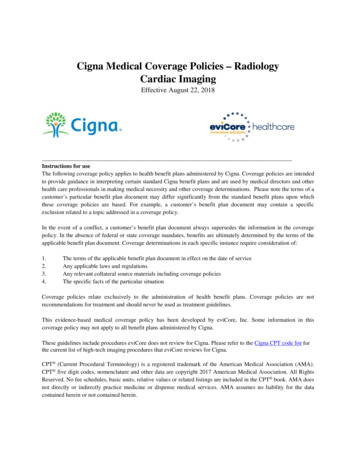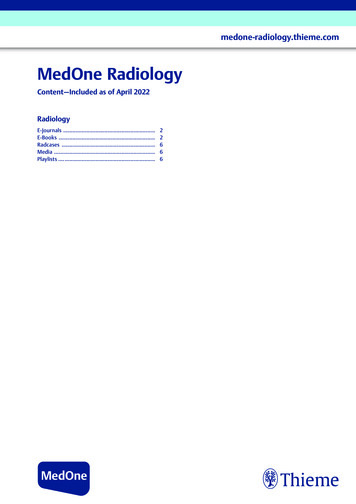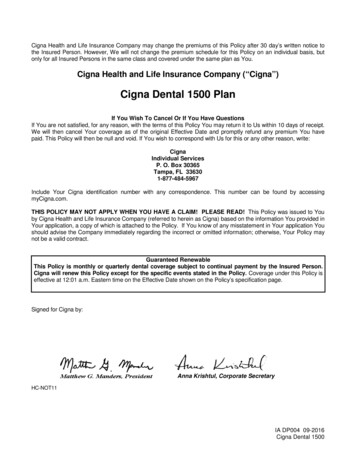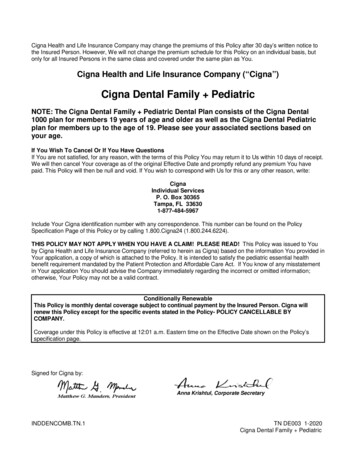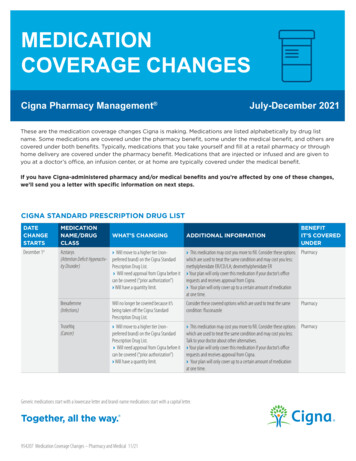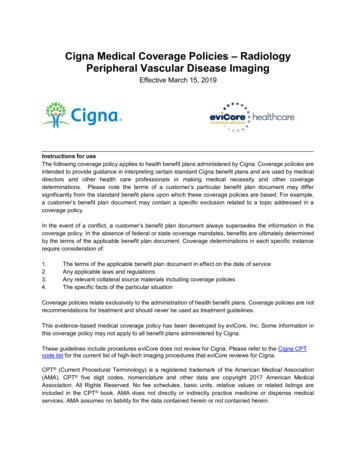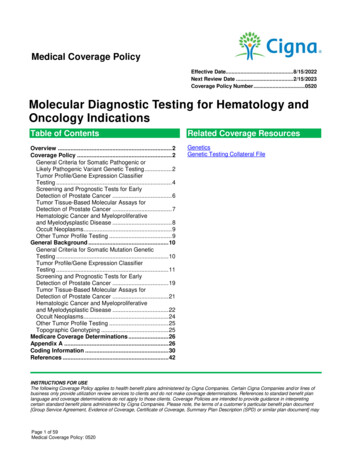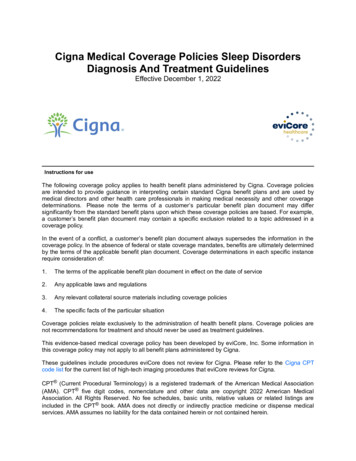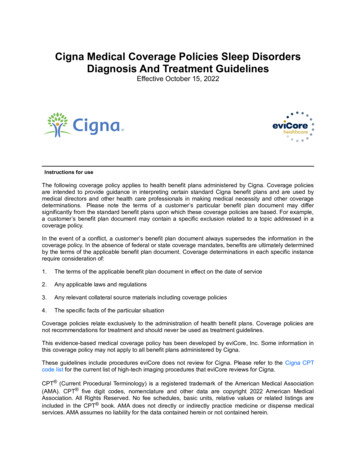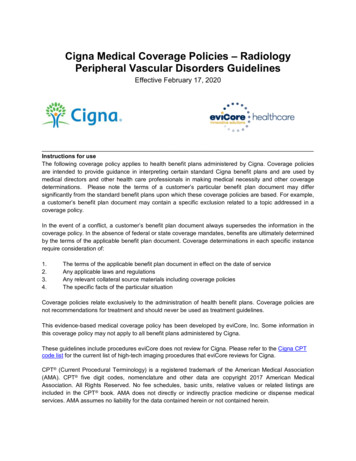
Transcription
Cigna Medical Coverage Policies – RadiologyPeripheral Vascular Disorders GuidelinesEffective February 17, 2020Instructions for useThe following coverage policy applies to health benefit plans administered by Cigna. Coverage policiesare intended to provide guidance in interpreting certain standard Cigna benefit plans and are used bymedical directors and other health care professionals in making medical necessity and other coveragedeterminations. Please note the terms of a customer’s particular benefit plan document may differsignificantly from the standard benefit plans upon which these coverage policies are based. For example,a customer’s benefit plan document may contain a specific exclusion related to a topic addressed in acoverage policy.In the event of a conflict, a customer’s benefit plan document always supersedes the information in thecoverage policy. In the absence of federal or state coverage mandates, benefits are ultimately determinedby the terms of the applicable benefit plan document. Coverage determinations in each specific instancerequire consideration of:1.2.3.4.The terms of the applicable benefit plan document in effect on the date of serviceAny applicable laws and regulationsAny relevant collateral source materials including coverage policiesThe specific facts of the particular situationCoverage policies relate exclusively to the administration of health benefit plans. Coverage policies arenot recommendations for treatment and should never be used as treatment guidelines.This evidence-based medical coverage policy has been developed by eviCore, Inc. Some information inthis coverage policy may not apply to all benefit plans administered by Cigna.These guidelines include procedures eviCore does not review for Cigna. Please refer to the Cigna CPTcode list for the current list of high-tech imaging procedures that eviCore reviews for Cigna.CPT (Current Procedural Terminology) is a registered trademark of the American Medical Association(AMA). CPT five digit codes, nomenclature and other data are copyright 2017 American MedicalAssociation. All Rights Reserved. No fee schedules, basic units, relative values or related listings areincluded in the CPT book. AMA does not directly or indirectly practice medicine or dispense medicalservices. AMA assumes no liability for the data contained herein or not contained herein.
PVD Imaging GuidelinesV1.0Peripheral Vascular Disease (PVD) ImagingGuidelinesAbbreviations and Glossary for the PVD Imaging Guidelines3PVD-1: General Guidelines4PVD-2: Screening for Suspected Peripheral ArteryDisease/Aneurysmal DIsease10PVD-3: Cerebrovascular and Carotid Disease13PVD-4: Upper Extremity Peripheral Vascular Disease18PVD-5: Pulmonary Artery Hypertension21PVD-6: Aortic Disorders, Renal Vascular Disorders and VisceralArtery Aneurysms23PVD-7: Lower Extremity Peripheral Vascular Disease35PVD-8: Imaging for Hemodialysis Access42PVD-9: Arteriovenous Malformations (AVMs)44PVD-10: This section intentionally left blank45PVD-11: Venous Imaging – General Information46PVD-12: Acute Limb Swelling52PVD-13: Chronic Limb Swelling Due to Chronic Deep VenousThrombosis/May Thurner’s Syndrome55PVD-14: Chronic Limb Swelling Due to Venous Insufficiency/VenousStasis Changes/Varicose Veins58PVD-15: Venous Stasis Ulceration62PVD-16: IVC Filters64PVD-17: Post Iliac Vein Stent/Angioplasty66 2019 eviCore healthcare. All Rights Reserved.Page 2 of 67400 Buckwalter Place Boulevard, Bluffton, SC 29910 (800) 918-8924www.eviCore.com
PVD Imaging GuidelinesV1.0Abbreviations and Glossary for the PVDImaging Guidelines(See also: Cardiac Imaging Guidelines Glossary)AAAABIabdominal aortic aneurysmAnkle brachial index: a noninvasive, non-imaging test for arterialinsufficiency – (see toe-brachial index below). This testing can also bedone after exercise if resting results are normal.Claudication or Intermittent claudication: usually a painful cramping sensation ofthe legs with walking or severe leg fatigueCTAcomputed tomography angiographyCTVcomputed tomography venographyDLCOdiffusion capacity: defined as the volume of carbon monoxidetransferred into the blood per minute per mmHg of carbon monoxidepartial pressureDVTdeep venous thrombosisECGelectrocardiogramENTEars, Nose, ThroatHbA1Chemoglobin A1C: test used to determine blood sugar control forindividuals with diabetesMRAmagnetic resonance angiographyMRVmagnetic resonance venographyPADperipheral artery diseasePAHpulmonary artery hypertensionPFTpulmonary function testsPVDperipheral vascular diseaseSVCsuperior vena cavaTIAtransient ischemic attackTTEtransthoracic echocardiogramToeuseful in individuals with ABI above the normal range due to nonBrachialcompressible posterior tibial or dorsalis pedis arteriesIndexV/Q Scanventilation and perfusion scan 2019 eviCore healthcare. All Rights Reserved.Page 3 of 67400 Buckwalter Place Boulevard, Bluffton, SC 29910 (800) 918-8924www.eviCore.com
PVD Imaging GuidelinesPVD-1: General GuidelinesPVD-1.1: General InformationPVD-1.2: Procedure CodingPVD-1.3: General Guidelines – ImagingV1.0568 2019 eviCore healthcare. All Rights Reserved.Page 4 of 67400 Buckwalter Place Boulevard, Bluffton, SC 29910 (800) 918-8924www.eviCore.com
PVD Imaging GuidelinesV1.0PVD-1.1: General Information Risk factors for vascular disease include: Diabetes Cigarette smoking Hypertension Hyperlipidemia Age 50, with at least one risk factor, are considered “at risk” for vasculardisease. See PV-17: Impotence/Erectile Dysfunction in the Pelvis Imaging Guidelines. Signs and symptoms of peripheral arterial disease: Claudication (Cramping pain in the legs, most notably back of the calves but caninvolve hips or thighs, after walking which is relieved with rest but recurs at apredictable distance) Symptoms that are not consistent with claudication include: Generalized leg pain Nocturnal cramps Pain that is not easily relieved after a few minutes of rest Burning pain in feet Critical limb ischemia Rest pain: Pain in the foot (not leg) at rest, particularly at night when the leg iselevated. Pain is relieved by dangling the leg off the bed or moving to anupright position Non healing wounds. Wounds present for 2 weeks with little to no evidenceof healing Erectile dysfunction can be associated with vascular disease Claudication and critical limb ischemia have different natural histories. Claudicationgenerally follows a benign indolent course. 70% of individuals with claudication willhave the same symptoms after five years with no progression. Critical limb ischemia,on the other hand, is associated with a high rate of limb loss (25%) and death (35%)one year after presentation 2019 eviCore healthcare. All Rights Reserved.Page 5 of 67400 Buckwalter Place Boulevard, Bluffton, SC 29910 (800) 918-8924www.eviCore.comPeripheral Vascular Disease (PVD) Imaging A current clinical evaluation (within 60 days), including medical treatments, arerequired prior to considering advanced imaging, which includes: Relevant history and physical examination including: Palpation of pulses Evaluation of lower extremities for presence of non-healing wounds organgrene Associated skin changes such as thickened nails, absence of hair in the feetor calves, cool extremities Evaluation for the presence of arterial bruits Appropriate laboratory studies Non-advanced imaging modalities, such as recent ABIs (within 60 days) aftersymptoms started or worsened Other meaningful contact (telephone call, electronic mail or messaging) by anestablished individual can substitute for a face-to-face clinical evaluation.
PVD Imaging GuidelinesV1.0 Simultaneous venous and arterial systems evaluation are unusual but areoccasionally needed. Post angioplasty/reconstruction: follow-up imaging is principally guided bysymptoms. See PVD-6.8: Post Aortic Endovascular/Open Surgery Surveillance Studies PVD-7.3: Post-Procedure Surveillance StudiesPVD-1.2: Procedure CodingNon-Invasive Physiologic Studies of Extremity Arteries Limited bilateral noninvasive physiologic studies of upper or lower extremityarteries. Non-invasive physiologic studies of upper or lower extremity arteries, singlelevel, bilateral (e.g., ankle/brachial indices, Doppler waveform analysis,volume plethysmography, transcutaneous oxygen tension measurement).CPT 93922 Complete bilateral noninvasive physiologic studies of upper or lower extremityarteries, 3 or more levels.93923 CPT 93922 and CPT 93923 can be requested and reported only once for theupper extremities and once for the lower extremities. CPT 93922 and CPT 93923 should not be ordered on the same request nor billedtogether for the same date of service. CPT 93924 and CPT 93922 and/or CPT 93923 should not be ordered on thesame request and should not be billed together for the same date of service. ABI studies performed with handheld dopplers, where there is no hard copy outputfor evaluation of bidirectional blood flow, are not reportable by these codes.Non-Invasive Physiologic Studies of Extremity ArteriesCPT Non-invasive physiologic studies of lower extremity arteries, at rest and followingtreadmill stress testing, complete bilateral study.Arterial Duplex – Upper and Lower ExtremitiesDuplex scan of lower extremity arteries or arterial bypass grafts; complete bilateral.93924CPT 93925 A complete duplex scan of the lower extremity arteries includes examination of the fulllength of the common femoral, superficial femoral and popliteal arteries. The iliac, deep femoral, and tibioperoneal arteries may also be examined.Duplex scan of lower extremity arteries or arterial bypass grafts; unilateral or limitedstudy.93926 2019 eviCore healthcare. All Rights Reserved.Page 6 of 67400 Buckwalter Place Boulevard, Bluffton, SC 29910 (800) 918-8924www.eviCore.comPeripheral Vascular Disease (PVD) Imaging Non-invasive physiologic studies of upper or lower extremity arteries, multiplelevels or with provocative functional maneuvers, complete bilateral study(e.g., segmental blood pressure measurements, segmental Dopplerwaveform analysis, segmental volume plethysmography, segmentaltranscutaneous oxygen tension measurements, measurements with posturalprovocative tests, measurements with reactive hyperemia).
PVD Imaging GuidelinesV1.0Arterial Duplex – Upper and Lower ExtremitiesCPT The limited study is reported when only one extremity is examined or when less than afull examination is performed (e.g. only one or two vessels or follow-up).Duplex scan of upper extremity arteries or arterial bypass grafts; complete bilateral.93930 A complete duplex of the upper extremity arteries includes examination of thesubclavian, axillary, and brachial arteries. The radial and ulnar arteries may also be included.Duplex scan of upper extremity arteries or arterial bypass grafts; unilateral or limitedstudy.93931 The limited study is reported when only one extremity is examined or when less than afull examination is performed (e.g. only one or two vessels or follow-up).Cerebrovascular Artery StudiesDuplex scan of extracranial arteries; complete bilateral study.Duplex scan of extracranial arteries; unilateral or limited study.CPT 9388093882 This study is often referred to as a “carotid ultrasound” or “carotid duplex”. Typically, it includes evaluation of the common, internal, and external carotid arteries.CPT Transcranial Doppler study of the intracranial arteries; complete studyTranscranial Doppler study of the intracranial arteries; limited study9388693888Transcranial Doppler vasoreactivity study93890Transcranial Doppler study of the intracranial arteries; emboli detection withoutintravenous microbubble injectionTranscranial Doppler study of the intracranial arteries; emboli detection withintravenous microbubble injection93892Venous Studies - ExtremitiesNon-invasive physiologic studies of extremity veins, complete bilateral study (e.g.Doppler waveform analysis with responses to compression and other maneuvers,phleborheography, impedance plethysmography). This study is rarely performed.Duplex scan of extremity veins, including responses to compression and othermaneuvers; complete bilateral study.Duplex scan of extremity veins, including responses to compression and othermaneuvers; unilateral or limited study.93893CPT 939659397093971 These codes are used to report studies of lower or upper extremity veins. A complete bilateral study of the lower extremity veins includes examination of thecommon femoral, proximal deep femoral, great saphenous and popliteal veins. Calfveins may also be included. A complete bilateral study of upper extremity veins includes examination of thesubclavian, jugular, axillary, brachial, basilica, and cephalic veins. Forearm veins mayalso be included. 2019 eviCore healthcare. All Rights Reserved.Page 7 of 67400 Buckwalter Place Boulevard, Bluffton, SC 29910 (800) 918-8924www.eviCore.comPeripheral Vascular Disease (PVD) ImagingTranscranial Doppler Studies
PVD Imaging GuidelinesV1.0Visceral Vascular StudiesDuplex scan of arterial inflow and venous outflow of abdominal, pelvic, scrotalcontents and/or retroperitoneal organs; complete studyDuplex scan of arterial inflow and venous outflow of abdominal, pelvic, scrotalcontents and/or retroperitoneal organs; limited studyDuplex scan of aorta, inferior vena cava, iliac vasculature, or bypass grafts;complete studyDuplex scan of aorta, inferior vena cava, iliac vasculature, or bypass grafts;unilateral or limited studyDuplex for Hemodialysis AccessDuplex scan of hemodialysis access (including arterial inflow, body of access andvenous outflow).CPT 93975939769397893979CPT 93990PVD-1.3: General Guidelines – Imaging Imaging Studies: Carotid studies (MRA Neck or CTA Neck) capture the area from the top of theaortic arch (includes the origin of the innominate artery, common carotid artery,and subclavian artery, which gives off the vertebral artery) to the base of theskull. CTA or MRA Abdomen (CPT 74175 or CPT 74185) images from the diaphragmto the umbilicus or iliac crest. CTA or MRA Chest (CPT 71275 or CPT 71555) images from the base of theneck to the dome of the liver. Runoff studies (CPT 75635 for CTA or CPT 74185, CPT 73725, and CPT 73725 for MRA) image from the umbilicus to the feet. CTA Abdomen and lower extremities should be reported as CPT 75635,rather than using the individual CPT codes for the abdomen, pelvis, and legs MRA Abdomen, MRA Pelvis and MRA Lower extremities should be reportedas CPT 74185, CPT 73725, and CPT 73725. The CPT code for MRAPelvis (CPT 72198) should not be included in this circumstance. If a prior imaging study (Ultrasound, MRA, CTA, Catheter angiogram, etc.) hasbeen completed for a condition, a follow-up, additional, or repeat study for thesame condition is generally not indicated unless there has been a change in theindividual’s condition, previous imaging showed an indeterminate finding, oreviCore healthcare guidelines support routine follow-up imaging. 2019 eviCore healthcare. All Rights Reserved.Page 8 of 67400 Buckwalter Place Boulevard, Bluffton, SC 29910 (800) 918-8924www.eviCore.comPeripheral Vascular Disease (PVD) Imaging ABI should be measured first: If normal, then further vascular studies are generally not indicated. If clinical suspicion for PAD remains high with normal ABI’s, exercise ABI’s(CPT 93924) can be performed on a treadmill to elicit ischemia The TBI (toe-brachial index) is used to establish the diagnosis of PAD in thesetting of non-compressible arteries (ABI 1.40) and may also be used to assessperfusion in individuals with suspected CLI (rest pain and/or non-healing wound)
PVD Imaging GuidelinesV1.0ReferencesPeripheral Vascular Disease (PVD) ImagingGerhard-Herman MD, Gornik HL, Barrett C, et al. 2016 AHA/ACC Guideline on the management ofpatients with lower extremity peripheral artery disease. J Am Coll Cardiol. 2017 Mar 69;(11):14671508.Perlstein TS and Creager MA. The ankle-brachial index as a biomarker of cardiovascular risk: it’s notjust about the legs. Circulation. 2009 Nov 29;120(21):2033-2035. 2019 eviCore healthcare. All Rights Reserved.Page 9 of 67400 Buckwalter Place Boulevard, Bluffton, SC 29910 (800) 918-8924www.eviCore.com
PVD Imaging GuidelinesV1.0PVD-2: Screening for Suspected PeripheralArtery Disease/Aneurysmal DIseasePVD-2.1: Asymptomatic Screening11PVD-2.2: Screening for Vascular Related Genetic Connective TissueDisorders (Familial Aneurysm Syndromes/Spontaneous CoronaryArtery Dissection (SCAD)/Ehlers-Danlos/Marfan/Loeys-Dietz)11PVD-2.3: Screening for TAA in Individuals with Bicuspid AorticValves11 2019 eviCore healthcare. All Rights Reserved.Page 10 of 67400 Buckwalter Place Boulevard, Bluffton, SC 29910 (800) 918-8924www.eviCore.com
PVD Imaging GuidelinesV1.0PVD-2.1: Asymptomatic Screening Routine screening of asymptomatic individuals for PAD is not advised. Those withCVD risk factors should be placed on best medical management and should bequestioned on symptoms of PAD at annual physicals Resting ABI’s (CPT 93922) may be appropriate in individuals with abnormal pulseexams. Currently, there is no evidence to demonstrate that screening all individuals withPAD for asymptomatic atherosclerosis in other arterial beds improves clinicaloutcome Screening for Familial Syndromes in individuals with a positive family history (1stdegree relative with dissection/TAA) but no known genetic syndrome/mutation,otherwise known as Suspected Familial Aneurysm syndrome ECHO (CPT 93306, CPT 93307, or CPT 93308) and chest x-ray for all Firstdegree relatives (parents, siblings, children) of individuals with TAA and/ordissection Any imaging listed can be performed if these studies identify a TAA or areequivocal or do not visualize the ascending aorta adequately Studies can be repeated at 2 year intervals if negative Follow-Up per TAA Follow-Up guidelines For individuals with documented Marfan/Loeys-Dietz/Ehlers-Danlos type IV oninitial diagnosis full vascular imaging should be performed from head to pelviswith CTA Head, carotid duplex, CTA Chest or CT Chest with contrast, andabdominal duplex. If there are no identified aneurysms or dissections, repeatimaging can be obtained at 2 year intervals Imaging should be every 6 months once an aneurysm has been identified until adecision has been made to repair Intracranial aneurysm – CTA or MRA Head Aneurysm of a cervical artery – Carotid duplex or CTA Neck if unable to fullyvisualize with carotid duplex Thoracic aorta – CTA Chest or CT Chest with or without contrast Abdominal aneurysm – Abdominal duplex Visceral aneurysm – These can be difficult to visualize on duplex. If not visibleon duplex, can obtain a CTA AbdomenPVD-2.3: Screening for TAA in Individuals with Bicuspid Aortic Valves Screening in individuals with bicuspid aortic valve: Screening, any requested imaging from the “Table of Thoracic Aorta ImagingOptions” in PVD 6.2 Thoracic Aortic Aneurysm (TAA) and/or ECHO (CPT 93306, CPT 93307, or CPT 93308) 2019 eviCore healthcare. All Rights Reserved.Page 11 of 67400 Buckwalter Place Boulevard, Bluffton, SC 29910 (800) 918-8924www.eviCore.comPeripheral Vascular Disease (PVD) ImagingPVD-2.2: Screening for Vascular Related Genetic Connective TissueDisorders (Familial Aneurysm Syndromes/Spontaneous CoronaryArtery Dissection (SCAD)/Ehlers-Danlos/Marfan/Loeys-Dietz)
PVD Imaging GuidelinesV1.0 Additional imaging such as Cardiac MRI, Cardiac CT, or CCTA is NOTgenerally indicated There is no evidence-based data to support screening relatives of individualswith bicuspid aortic valve Follow-up per TAA Follow-Up guidelines See PVD 6.2 Thoracic AorticAneurysm (TAA) If no dilatation of the aortic root or ascending thoracic aorta is found, there is noevidence-based data to support continued surveillance imagingGerhard-Herman MD, Gornik HL, Barrett C, et al. 2016 AHA/ACC Guideline on the Management ofPatients With Lower Extremity Peripheral Artery Disease: Executive Summary. Journal of theAmerican College of Cardiology. 2017;69(11):1465-1508. doi:10.1016/j.jacc.2016.11.008.Perlstein TS, Creager MA. The Ankle-Brachial Index as a Biomarker of Cardiovascular Risk.Circulation. 2009;120(21):2033-2035. doi:10.1161/circulationaha.109.907238.Saydah SH, Poor Control of Risk Factors for Vascular Disease among Adults with PreviouslyDiagnosed Diabetes. JAMA. 198035. PublishedJanuary 21, 2004.Hennion DR, Siano KA. Diagnosis and Treatment of Peripheral Arterial Disease. American FamilyPhysician. 130901p306-c1. PublishedSeptember 1, 2013.Hirsh AT. Peripheral Arterial Disease Detection, Awareness, and Treatment in Primary Care. Jama.2001;286(11):1317. doi:10.1001/jama.286.11.1317.Mohler ER, Gornik HL, Gerhard-Herman M, Misra S, Olin JW, Zierler VS 2012 Appropriate Use Criteria forPeripheral Vascular Ultrasound and Physiological Testing Part I: Arterial Ultrasound andPhysiological Testing. Journal of the American College of Cardiology. US Preventive Services Task Force, Curry SJ, Krist AH, et al. Screening for Peripheral ArteryDisease and Cardiovascular Disease Risk Assessment With the Ankle-Brachial Index:US PreventiveServices Task Force Recommendation Statement. Jama. 2018;320(2):177.doi:10.1001/jama.2018.8357.MS Conte, FB Pomposelli, DG Clair, et al. Society for Vascular Surgery practice guidelines foratherosclerotic occlusive disease of the lower extremities: Management of asymptomatic disease andclaudication. Journal of Vascular Surgery 2015. Vol 6:1S-41S.MacCarrick G, III JHB, Bowdin S, et al. Loeys–Dietz syndrome: a primer for diagnosis andmanagement. Nature News. https://www.nature.com/articles/gim201411. Published February 27,2014.Olin JW, Gornik HL, Bacharach JM, et al. Fibromuscular Dysplasia: State of the Science and CriticalUnanswered Questions. Circulation. 7.96802.8c.Persu A, Niepen PVD, Touzé E, et al. Revisiting Fibromuscular Dysplasia. Hypertension.2016;68(4):832-839. doi:10.1161/hypertensionaha.116.07543.Hayes SN, Kim ES, Saw J, et al. Spontaneous Coronary Artery Dissection: Current State of theScience: A Scientific Statement From the American Heart Association. Circulation. tzka LF, Bakris GL, Beckman JA, et al. 2010ACCF/AHA/AATS/ACR/ASA/SCA/SCAI/SIR/STS/SVM guidelines for the diagnosis and managementof patients with thoracic aortic disease. J Am Coll Cardiol 2010; 55: e27-e129. 2019 eviCore healthcare. All Rights Reserved.Page 12 of 67400 Buckwalter Place Boulevard, Bluffton, SC 29910 (800) 918-8924www.eviCore.comPeripheral Vascular Disease (PVD) ImagingReferences
PVD Imaging GuidelinesV1.0PVD-3: Cerebrovascular and Carotid DiseasePVD-3.1: Initial Imaging14PVD-3.2: Surveillance Imaging with NO History of Carotid Surgeryor Intervention15PVD-3.3: Surveillance Imaging WITH History of Carotid Surgery orIntervention16 2019 eviCore healthcare. All Rights Reserved.Page 13 of 67400 Buckwalter Place Boulevard, Bluffton, SC 29910 (800) 918-8924www.eviCore.com
PVD Imaging GuidelinesV1.0 Duplex ultrasound (CPT 93880 bilateral or CPT 93882 unilateral), prior toconsidering advanced imaging, should generally be used to evaluate possiblecarotid artery disease when ANY of the following apply: Hemispheric neurologic symptoms including stroke, TIA, or amaurosis fugax Known or suspected retinal arterial emboli or Hollenhorst plaque Suspected carotid dissection Pulsatile neck masses Carotid or cervical bruit Abnormal findings on physical exam of the carotid arteries (e.g. aneurysm orabsent carotid pulses) Preoperative evaluation of individuals with evidence of severe diffuseatherosclerosis, scheduled for major cardiovascular surgical procedures Preoperative evaluation of individuals prior to elective coronary artery bypassgraft (CABG) surgery in individuals older than 65 years of age and in those withperipheral artery disease, history of cigarette smoking, history of stroke or TIA, orcarotid bruit Suspected Subclavian Steal Syndrome See CH-27: Subclavian Steal Syndrome in the Chest Imaging Guidelines Blunt neck trauma Neurologic complaints after chiropractic neck manipulation Vasculitis potentially involving carotid arteries, i.e. Takayasu’s arteritis andfibromuscular dysplasia (FMD) Carotid ultrasound screening in asymptomatic individuals due only to risk factors isnot indicated New signs and symptoms consistent with carotid artery disease (e.g. TIA, amaurosisfugax, change in nature of a carotid bruit) are an indication to re-image the cervicalvessels (regardless of when the previous carotid imaging was performed) using ANYof the following: Duplex ultrasound (CPT 93880 bilateral study or CPT 93882 unilateral study), MRA Neck with contrast (CPT 70548) or without and with contrast (CPT 70549), CTA Neck (CPT 70498) For Typical Symptoms of TIA/Stroke or Carotid Dissection: See HD-21: Stroke/TIA in the Head Imaging Guidelines For Suspected Vertebrobasilar Pathology: Initial Imaging See HD-21: Stroke/TIA in the Head Imaging Guidelines Surveillance Imaging Asymptomatic or unchanged symptoms and known vertebrobasilar disease orpost-stenting interval determined by Vascular Specialist After Intracranial Hemorrhage: Initial Imaging See HD-13.1: Head Trauma in the Head Imaging Guidelines Surveillance Imaging Interval determined by neurosurgeon or neurologist 2019 eviCore healthcare. All Rights Reserved.Page 14 of 67400 Buckwalter Place Boulevard, Bluffton, SC 29910 (800) 918-8924www.eviCore.comPeripheral Vascular Disease (PVD) ImagingPVD-3.1: Initial Imaging
PVD Imaging GuidelinesV1.0 For Suspected Subclavian Steal Syndrome: Initial imaging should be a carotid duplex If initial duplex demonstrates high grade stenosis or occlusion of thesubclavian artery, advanced imaging is NOT indicated unless the individual issymptomatic with arm claudication or signs of hypo-perfusion of the vertebralartery with recurrent dizziness Surveillance of subclavian arterial disease is NOT indicated if there has not beenany intervention such as a carotid-subclavian bypass or subclavian stent Advanced imaging See CH-27: Subclavian Steal Syndrome in the ChestImagingPVD-3.2: Surveillance Imaging with NO History of Carotid Surgery orIntervention Surveillance imaging once a year for individuals with fibromuscular dysplasia of theextracranial carotid arteries. If normal study, no routine follow-up imaging is indicated If 50% carotid stenosis Duplex ultrasound (CPT 93880 bilateral or CPT 93882 unilateral) can beperformed every two years Between 50% and 70% carotid stenosis Duplex ultrasound (CPT 93880 bilateral or CPT 93882 unilateral) can beperformed annually A repeat duplex (CPT 93880 bilateral or CPT 93882 unilateral) may beperformed in three to six months until stability is reached when ONE of thefollowing occurs: Change in the character of the bruit 2019 eviCore healthcare. All Rights Reserved.Page 15 of 67400 Buckwalter Place Boulevard, Bluffton, SC 29910 (800) 918-8924www.eviCore.comPeripheral Vascular Disease (PVD) Imaging Reporting standards for carotid stenosis varies widely. The most commonly usedcriteria, however, is noted in the chart below published by the Society of Radiologyin 2003
PVD Imaging GuidelinesV1.0 Duplex demonstrates rapid progression, including: Doubling of peak systolic velocities Increase of the ICA/CCA ratio Heavy calcification Thrombus Ulcerated plaque Echolucent plaque Carotid stenosis 70% or ICA/CCA ratio 4 Duplex ultrasound (CPT 93880 bilateral or CPT 93882 unilateral) or MRA Neckwith contrast (CPT 70548) or CTA Neck (CPT 70498) at the following intervals: Every 6 months until ONE of the following occurs: Intervention is performed Decision is made to not intervene MRA Neck with contrast (CPT 70548) or CTA Neck (CPT 70498) if duplexUltrasound shows 70% occlusion/stenosis of the internal carotid artery OR theICA/CCA ratio is 4.0 even with a lower percentage of stenosis If carotid stent is planned MRA Head (CPT 70544) or CTA Head (CPT 70496) can be added Duplex ultrasound (CPT 93880 bilateral or CPT 93882 unilateral) post carotidsurgery or intervention at the following intervals: 1 month after procedure Every 6 months for 2 years after procedure Then annually If 70% residual carotid stenosis is seen at 1 month after procedure Duplex ultrasound (CPT 93880 bilateral or CPT 93882 unilateral) at thefollowing intervals: Every 3-6 months for one year Then annuallyBackground and Supporting Information Carotid intima-media thickness using duplex ultrasound imaging (Category III code0126T) is not recommended in clinical practice for risk assessment for a first ASCVDevent. Although outcomes data are lacking, Texas has adopted this method in TexasHeart Attack Preventive Screening Bill (HR 1290). Texas Heart Attack Preventive Screening Law (HR 1290) mandates that insurers inTexas cover either a calcium scoring study (CPT 75571 or HCPCS S8092) or acarotid intima-media thickness study (ultrasound—Category III code 0126T) everyfive years for certain populations. To qualify, the following must apply: Must be a Texas resident Must be a member of a fully-insured Texas health plan Must be a man age 45 to 75 or a woman age 55 to 75 2019 eviCore healthcare. All Rights Reserved.Page 16 of 67400 Buckwalter Place Boulevard, Bluffton, SC 29910 (800) 918-8924www.eviCore.comPeripheral Vascular Disease (PVD) ImagingPVD-3.3: Surveillance Imaging WITH History of Carotid Surgery orIntervention
PVD Imaging GuidelinesV1.0 Must have either diabetes or a Framingham cardiac risk score of intermediate orhigher Must not have had a calcium scoring study or a carotid intima-media thicknessstudy w
The following coverage policy applies to health benefit plans administered by Cigna. Coverage policies . Stasis Changes/Varicose Veins 58 PVD -15: Venous Stasis Ulceration 62 . IVC Filters 64 PVD -17: Post Iliac Vein Stent/Angioplasty 66 Page 2 of 67 PVD Imaging Guidelines V1.0 .
